
By David Dalrymple
When we speak of vehicle fires today, at least from a respiratory protection standpoint, the best practices approach from a worldwide perspective is, “Don positive-pressure, self-contained breathing apparatus (SCBA) during suppression operations and also during postsuppression overhaul operations while smoke, vapor, and particles are present.” However, this is on public roads, streets, highways, and motorways. What of motorsports? We rarely see SCBA at a motorsports venue, at least not seemingly beyond tokenism.
Why is this? We know better as emergency responders. I watched the Australian Grand Prix recently, and one of the Haas F1 cars came in with an apparent fire in its engine bay. There was no visible fire, but there was quite a bit of smoke. When the car stopped and the driver started to exit the vehicle, there were two pit road firefighters with dry power extinguishers and three Haas crew members with foam air-pressurized water extinguishers at the vehicle. The Haas crew was actively putting agent on the vehicle. It seemed to be a good job, especially with what looked like a wetting agent, not a foam!
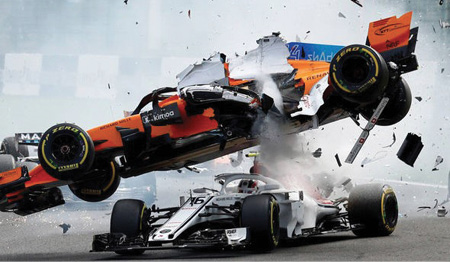
(1) Formula 1 crash in August 2018, Spa Race Circuit Belgium. (Photo courtesy of F1Media; other photos by author unless otherwise noted.)
Respiratory Protection
But not one person had any form of respiratory protection. You might say, “Those cars don’t have a large fuel load.” Besides carrying enough fuel for an entire race, there’s a high-energy battery. Most of the body is made from composite material and combustible alloys. Do not forget that hidden by the smoke are various acids and gases off-gassed as a by-product of combustion that are toxic to breathe.
Let’s look at passenger cars and fires involving them. Today’s vehicles are manufactured from hundreds of pounds of plastics of various forms. Alloys of many types make up the vehicle structure and reinforce its integrity. Some forms of carbon fiber materials are used for bodywork and structural reinforcements. Alternative fueled drivetrains are the rage now, so high-voltage batteries can be found in these vehicles as well. Add into the mix a large amount of some type of fuel, except on fully electric vehicles. All of these materials come together when there’s a fire and produce a huge amount of toxic gases, acids, carcinogens, dusts, and particles that are major health threats for responders.
Fires are attacked with 1¾-inch hand-lines flowing 100 gallons per minute, preferably with foam or a wetting agent. SCBA is worn during suppression and overhaul operations basically whenever there is a possibility of smoke, vapors, and particles released into the air. This is best practice for the world fire services.
Why is this not best practice at a racetrack? Cost and logistics involving the initial outlay and subsequent upkeep are significant considerations for the small tracks. A frequent argument is that such an investment is overkill for how often a significant fire will occur.
The Risks in a Car Fire
Polymers, plastics, composites, combustible alloys, and related materials are bad news in a fire. There is quite a bit of literature about fires in passenger vehicles and how firefighters’ health and safety are affected. The studies of the past 15 years have recommended that firefighters wear SCBA at these incidents.
The question is, if SCBA is recommended for these emergencies that occur out in open air, why hasn’t the question of responder respiratory protection been studied in conjunction with indoor track fires? There is an abundance of information from the U.S. Air Force and U.S. Naval Aviation on the topic as it relates to air shows. The reports cover aircraft crashes, fires, and cleanups of aircraft with large amounts of composites. There is a free online program to train firefighters to handle damaged composite materials and fires involving them.
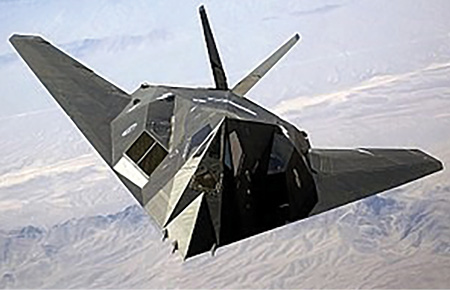
(2) A U.S. Air Force F-117A Nighthawk Stealth Fighter. (Photo courtesy of U.S. Air Force.)
For example, an F-117A Nighthawk crashed at an air show near Baltimore, Maryland. The pilot ejected safely, and the aircraft crashed into an empty field and caught fire, consuming the wreckage. The airport firefighters knocked down the fire; but because of the large amount of composite material present, the local county fire service had to remain on scene to cool the wreckage for an extended period. In addition, they assisted the military with the cleanup. The interesting thing in the report was that 40 firefighters had to be checked in at an emergency room at various times because of respiratory complaints, flu-like symptoms, and punctures and lacerations from broken materials.
A tactic to limit these hazardous effects outlined in the reports was to spray the broken wreckage as soon as possible with a floor wax or some type of polymer to keep the quantity of dust and particles down and bound with the material. The theory behind this tactic is that the fire melts or burns away the resins of the composite, leaving the strands of material exposed. The floor wax acts as a bonding agent to keep the strands together. It is interesting to say the least, since depending on the size of the crash, they would still be suppressing the fire while starting to spray this bonding agent.
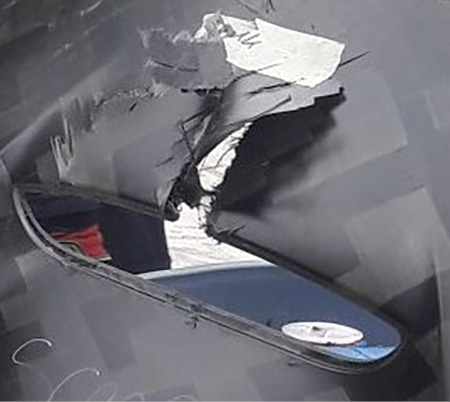
(3) A broken carbon fiber hood. Notice the strands of carbon fiber woven material.
The Air Force and Naval literature also outlines many of the composite materials and their components. Depending on the composite material, the broken fibers could potentially enter the bloodstream and circulate and lodge in the heart or brain. All the broken fibers can inflict severe lacerations and puncture wounds and defeat most conventional personal protective equipment (PPE) firefighters would be wearing. Additionally, many of these dusts and particles are respiratory irritants.

(4) Carbon fiber broken strands of material.
Motorsports Applications
How does this information apply to motorsports? In motorsports, the majority of vehicles have composite materials to some degree. Therefore, in a crash, there may be damaged or broken composite materials lying on the racing surface. In a fire situation, we can also expect that some composite materials would be involved. SCBA would be the best choice for protecting against respiratory exposure, but it may not be practical.
Before we go to PPE options, let’s quickly look at the nonfire hazard of composites that are just as bad and just as toxic, airborne dusts and fibers. They can be created from cutting/severing during extrication evolutions, damage from a crash, and even simply piling up crash debris. Depending on the tool being used for extrication, such as a power hydraulic cutter, there will be chunks and “strands” of fibers deceivingly weak and soft but razor sharp with the strength of steel. Yet, use of a reciprocating saw on carbon fiber panels or components will create a fine powdery “dust” that will quickly become airborne. It is abrasive enough to tear teeth and carbide tips off any reciprocating saw blade on the market.
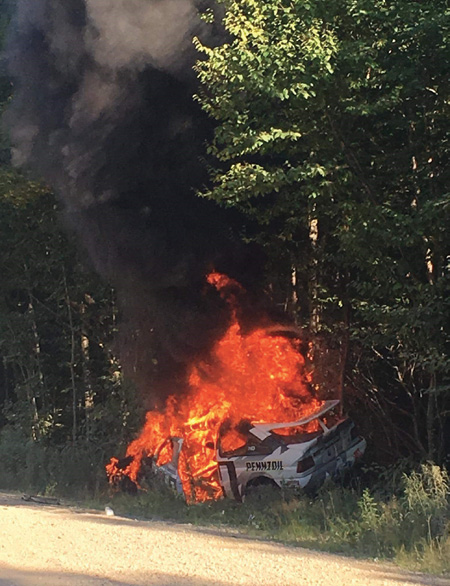
(5) A Ford Ex-World Rally Championship Group A Sierra Cosworth Escort, postcrash. The ARA open class rally car was driven by K. Block.
What happens with this dust when it gets on your gear and on you? It stays until it is cleaned off. That means you need to decon or at least use decon wipes. If you use wash-down decon, you must collect the water runoff because it is contaminated. Think of the ramifications of a “simple” incident resourcewise. Many street vehicles today have quantities of composites onboard; the color (black) and pattern weave usually are telltale signs but not absolutely.
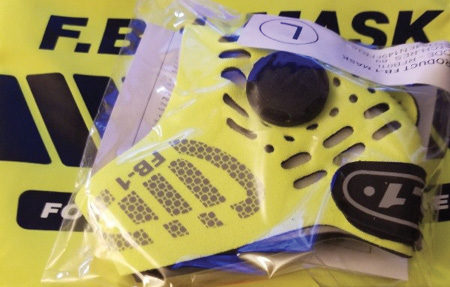

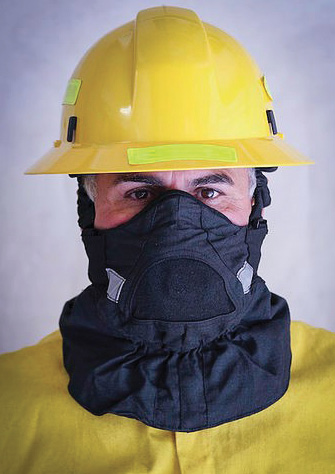
(6-8) Versions of masks that are appropriate alternatives to an SCBA.
In addition to the cost, there is the operational factor. A rapid response is needed for a fire in a motorsports venue, especially if the driver is still in the vehicle. There may not be enough time to don SCBA, mount the vehicle, and respond. It could be argued that SCBA would need to be worn continuously in the vehicle so firefighters could be ready at any point in the event—and, we’re just talking about the firefighters in the response vehicles. What about the pit road firefighters? Although you can wear SCBA, some events are at least two-plus hours in length—for instance, endurance races may be 12 or 24 hours long. This means that many air cylinders will be needed.
Some may argue that most fires are not very large, so why bother with SCBA? Remember, all exposures are cumulative.
Alternatives to an SCBA
There are some appropriate alternatives to an SCBA. The first is a mask used by the fire service in the United Kingdom for overhaul. It is also effective against dust and particles at a motor vehicle crash. The mask can be donned and doffed with all PPE in place because of its self-fastening closure. It has two replaceable/changeable filters in the front. I have found these masks comfortable and appropriate for vehicle rescue training for managing glass.
A second option is a mask that is designed for the public safety environment. The filter is above the grade of an N95 and has active carbon fiber filtration for chemicals and dusts and fibers; it has replaceable/changeable filters and is easy to don and doff, especially while wearing a helmet.
The third option is a face mask made from a man-made material that is nonflammable protection against burns to the face/neck and has the added benefit of blocking and reducing the inhalation of smoke and ash particulates. Multiple layers of material help maintain the airspace firefighters want and the human skin needs to survive extreme temperatures. The soft comfortable inside liners absorb perspiration, adding to user comfort. This also allows for the insertion of an N95 type of activated carbon disposable particulate filter.
There are other filtering masks much akin to a bandana; however, they are more environmental types of filters than a hazard type of filter. This is not an exhaustive review; there are other options to explore.
With regard to debris, just like any other debris on the racing surface, always assume it’s hot. The catch with composites is that you have to watch how you pick them up; even simply brushing by a piece of composite material can tear your PPE and cause injury. A laceration from composites will potentially leave behind microscopic hooks, much akin to self-fastening materials, on your skin that will need to be debrided just as skin that has sustained a significant burn.
Composite materials are used for safety on team vehicles, saving weight and adding strength, but they are a hazard when the vehicle crashes. Debris or fire makes these materials hazardous to work around. They cause not only lacerations, puncture wounds, and abrasions but also respiratory issues. Our PPE protects us to a certain extent against these wounds, but these materials can defeat our PPE.
No PPE to protect the respiratory tract is now in use at motorsport events. Along with this, we need to seriously look at research into PPE for the motorsports environment. We need to strive to improve all areas of our PPE but especially in the area of respiratory protection. My research into this topic has just scratched the surface.
Bibliography
Bowman, Howard; Davidson, Ross A; and Gogley. June 2003. Eric J. Engineering Sciences Division, Research Department, Naval Air Warfare Center Weapons Division, China Lake, California.
Costantino, Capt. Joseph; Jarbeau Jr, TSgt James J; Hintz, SSgt Tammy J; Hinojosa, Ms. Melissa. Composite Material Hazard Assessment at Crash Sites, Update, 2015. Maj Christopher W. Edwards, Capt. Timothy W. Batten. Maj Jon E. Black. Jan. 2015. Air Force Research Laboratory, 711th Human Performance Wing, School of Aerospace Medicine, Occupational & Environmental Health Dept., Consultative Services Division Wright-Patterson AFB, OH.
Purser, David. Toxic Hazards to Fire Fighters, Including Effects of Fire Retardants, During Fires and Post-Fire Investigation Activities. 1998. Hartford Environmental Research, Hatfield, United Kingdom.
Wright, Mark T; Luers, Ariam C; Darwin, Robert L; and Scheffey, Joseph L. Composite Materials in Aircraft Mishaps Involving Fire: Updated, A Literature Review. Baltimore, MD: Hughes Associates, Inc., 2004.
DAVID DALRYMPLE has been involved with the emergency services for 34 years. He has been teaching vehicle rescue for the past 23 years to educate fellow responders on vehicle technology issues and concerns. He has taught at FDIC International since 2003. He is the author of the Vehicle Extrication Series DVDs (Fire Engineering) and is deeply involved in motorsports rescue. He is a member of the International Council of Motorsport Sciences.

